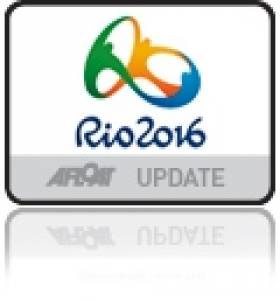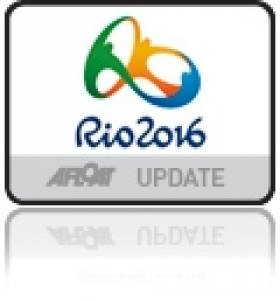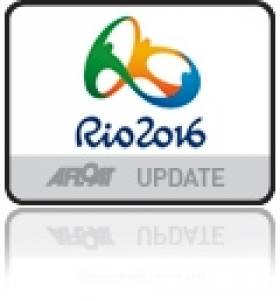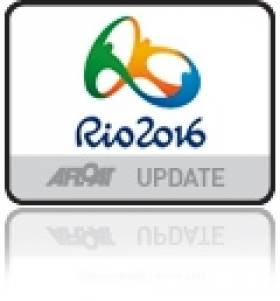Displaying items by tag: 49er
Annalise in Top Three at ISAF World Cup, Weymouth
#isafworldcup – Annalise Murphy is in the top three of the women's Laser Radial fleet at the ISAF World Cup fleet in Weymouth after today's two opening races in an 'uncommon' 15–knot easterly breeze. The Dun Laoghaire star scored a second in the first race and a sixth this afternoon in her 36–boat fleet. 16–year–old Aoife Hopkins of Howth Yacht Club, who earned her place by virtue of her performance (40th overall in an 82–boat fleet) at last month's Delta Lloyd regatta in Holland, lies 35th.
Belfast Lough's Ryan Seaton and Matt Mc Govern are 27th from 39th in the 49er skiff dinghy after counting a 13 and a disappointing 35 this afternoon.
In the women's skiff, Royal Irish pair Andrea Brewster and Saskia Tidey are scored as 'did not compete' in the first three races of the 49erFX class. Unfortunately the Dun Laoghaire pair were unable to race as a result of Tidey's 'suspected food poisoning' or 'some sort of vomiting bug'.
Ranging from 10-15 knots, the breeze coupled with glorious sunshine, resulted in some exceptional racing on the 2012 Olympic waters.
The stakes have been described as high by the competitors competing in Great Britain and rightly so with internal Rio qualification battles on-going, ISAF Sailing World Cup honours, a share of the prize fund and Abu Dhabi Final spots up for grab.
Racing commenced at 11:00 local time and wrapped up early evening with the ten Olympic, three Paralympic and Kiteboarding events completing their race schedule.
Laser
New Zealand's Andy Maloney came out with intent in the Laser, taking the day one lead with a strong performance as he explained, "We had good breeze between 10 and 15 knots. It was pretty shifty on the course but I had good pace and played the shifts and managed to come away with a first and second which is pretty solid. It was a good day."
The Road to Rio is a hard one and as well as international threats, Maloney also has to contend with domestic rivals on his journey. With the likes of his compatriots Sam Meech, Mike Bullot and Thomas Saunders all capable of challenging for medals, Maloney feels no internal pressure, "It's good for us and the Australians to have a good squad and we're all pushing each other hard.
"It's exciting more than anything now in the Laser because it's coming down to the final part of the cycle so it's crunch time now."
Yachting New Zealand named six crews for the Olympic Test Event on 18 May – see release here - . And as stated, will consider nominations the Laser following the World Cup Weymouth and Portland. A good performance by Maloney could go a long way for selection with Bullot in 15th, Saunders 20th and Sam Meech 21st after the opening day.
Nick Thompson (GBR) was not far off of Maloney's pace, finishing behind him in both races to sit in second.
London 2012 Olympic silver medallist Pavlos Kontides (CYP) was almost as strong in Weymouth and Portland's conditions as he did so well three years prior. A seventh and a fourth puts him third overall but he's got his eye on the top, "I'm satisfied with my performance and races today but there's still a long way to go and I hope to move up. Having 40 top guys with this new ISAF World Cup, the stakes are high.
"You have to push to the end and every race counts. You can win this event without winning any races. Consistency will prove vital in the end."
The day's remaining race win went the way of Jesper Stalheim (SWE) who is fourth overall.
Laser Radial
The last time Marit Bouwmeester (NED), Evi Van Acker (BEL) and Annalise Murphy (IRL) competed against each other at Weymouth and Portland they were locked in a battle for Olympic medals.
Fast forward three years and they're fighting it out again at the ISAF Sailing World Cup.
Marit Bouwmeester (NED) was assertive on the race course, winning both races by a comfortable margin. The Dutch sailor, who won silver at London 2012, sits atop the pile with Evi Van Acker, London 2012 bronze medallist, trailing on five points following a 3-2 scoreline.
Murphy came through in second in the opening race and followed it up with a sixth in Race 2. She is third on eight points.
Great Britain's Alison Young sits fourth on 13 points.
49er and 49erFX
On the face of the 49er results it would be quick to assume that leaders Lukasz Przybytek and Pawel Kolodzinski (POL) were the stand out performers of the day. However, regattas aren't won on the first they. It takes a consistent performance across five days of racing to come out on top and the most consistent team of the day were the first placed John Pink and Stu Bithell (GBR).
The pair recorded a 8-3-9 scoreline and were the only team to record three single digit scores. "On the first day of the regatta it's always nice to start well and we're thrilled to bits with three top tens. We're fifth overall which is great and tomorrow brings another challenge because it's going to be windy and we'll be pushing on and hopefully get into that top three.
"It's a great fleet, the top boats in the world are here and no one is really missing. It's great that everyone is competing in the ISAF Sailing World Cup."
Bithell won silver in the Men's 470 at London 2012 and on his home waters he knows what the venue is all about, "You could argue that I know Weymouth fairly well," he said with a smile. "I've lived here for some years now, did the Olympic Games here and is there a home advantage," he pondered, "yes there probably is but incidentally we don't always get the wind direction we had today."
The Polish crew lead on seven points with Pink and Bithell four points off the leaders. Nathan Outteridge and Iain Jensen (AUS) and Dylan Fletcher and Alain Sign (GBR) are tied on 8 points in second and third.
Maiken Foght Schutt and Anne-Julie Schutt (DEN) lead the way in the 49erFX on three points following scores of 6-2-1. Alex Maloney and Molly Meech (NZL) follow in second place on six points.
Sarah Steyaert and Aude Compan (FRA), Tamara Echegoyen and Berta Betanzos (ESP) and Martine Grael and Kahena Kunze (BRA) are tied on seven points from third to fifth.
Men's and Women's RS:X
It's a British 1-2 in the Men's RS:X and Women's RS:X. Nick Dempsey and Tom Squires are locked on three points apiece in the men's whilst Isobel Hamilton leads Bryony Shaw by a single point in the women's.
From three races Dempsey and Squires took a race victory each with the third place Mattia Camboni (ITA) taking the other.
"We had nice racing, very close," exclaimed Dempsey. "Tom and I are quicker than the fleet. Our training's gone really well and we're starting to sail well. It's nice and quite good fun racing."
The pair train together on a daily basis which has helped them in the build-up to the regatta as Dempsey explained, "It's nice having a competitive training partner. When we train we know we're training against one of the fastest people in the world.
"You never have to compensate. If you're beating Tom then you know you're going fast. That is what we've always missed having with our training partners so it's brilliant news."
"It's nice and quite good fun racing Tom."
In the Women's RS:X, Hamilton enjoyed a solid day on the water, staying at the front of the pack notching up a 6-2-2 scoreline. "It was definitely my best first day at a World Cup so far," said the smiling Hamilton, "I would love to be able to hold on to first for the whole week.
"It was really good racing and it's really nice to be racing at home. Weymouth is a fantastic venue and it's really great to be back here."
Shaw is a point off of Hamitlon after her 4-1-4 with London 2012 Olympic silver medallist Tuuli Petaja-Siren third overall. The day's race wins went to Joanna Sterling (AUS), Shaw and Ingrid Puusta (EST).
Finn
Andrew Murdoch (NZL) opened his Weymouth and Portland account with a strong display in the Finn, notching up a 3-2 to lead the 24-boat fleet.
Murdoch, a 2012 OIympian in the Laser, used his experience to full effect at the front of the fleet. He has opened up a four point lead over Jonathan Lobert (FRA).
Giles Scott (GBR) took the opening race victory of the day and followed it up with a 12th. He is third overall. The remaining race victory went the way of Josh Junior (NZL) who is sixth overall but just three points off the third placed Scott.
Men's and Women's 470
It's like London 2012 repeated in the Women's 470 with the gold and silver medallists occupying the spots they claimed three years ago.
Gold medallists Jo Aleh and Polly Powrie (NZL) dominated the day by taking both bullets whilst silver Hannah Mills and Saskia Clark (GBR) were forced to look at the back of the Kiwi boat in both races as they settled for two seconds.
Tina Mrak and Veronika Macarol (SLO) sit in third after the opening two races following a 4-3.
In the Men's 470, Stu McNay and David Hughes (USA) have a tasty six point lead over World #1 Panagiotis Mantis and Pavlos Kagialis (GRE). A fourth and a second gives them the lead at the early stage but with their experience, they won't be getting carried away.
Victories on the day went to the Greeks and Ferdinand Gerz and Oliver Szymanski (GER) who are sixth overall.
Nacra 17
As of 19:20 local time Thomas Zajac and Tanja Frank (AUT) lead the way in the Nacra 17. However, many of the competitors sailed the wrong course in Race 1 with Race Committee protests and vice versa. A handful of protests remain open that may result in further amendments.
As it stands the Austrians top the pile on four points followed by Matias Buhler and Nathalie Brugger (SUI) and Jason Waterhouse and Lisa Darmanin (AUS).
Paralympic Events
London 2012 Paralympic gold medallist Helena Lucas (GBR) began her World Cup campaign with intent. Double bullets give her a two point lead over Antonio Squizzato (ITA) who finished directly behind the Briton in both of the days races.
Malaysia's Al Mustakim Matrin sits in third overall.
In the SKUD18, Marco Gualandris and Marta Zanetti (ITA) and Alexandra Rickham and Niki Birrell (GBR) are level on three points.
The Italian and British teams shared the top two places on the day, taking a bullet and a second apiece.
Will Street and Megan Pascoe (GBR) are third overall.
It is tight at the top in the Sonar with four crews locked on five points.
Norway's Aleksander Wang-Hansen, Marie Solberg and Per Eugen Kristiansen took the opening bullet of the day and followed it up by a fourth.
John Robertson, Hannah Stodel and Steve Thomas (GBR) took the second bullet of the day but like the Norwegians also count a fourth.
Colin Harrison, Jonathan Harris and Russell Boaden (AUS) and John Twomey, Austrin O'Carroll and Ian Costelloe (IRL) notched up a second and a third each and are also tied with the Norwegian and Irish crews.
Racing resumes at 11:00 local time on Thursday 11 July with some great race action on the cards.
ISAF Votes for Double Points Medal Race for 49er & 49erFX at Rio 2016 Olympic Sailing Competition
The final day format for the 49er and the 49erFX Olympic regatta was a hotly discussed topic at the ISAF conference in Mallorca that drew to a close today. ISAF Council voted for one double points Medal Race without boundaries and a target time of 20 minutes.
It was also decided that all supplied equipment at the Rio 2016 Olympic Sailing Competition should be distributed after a public draw, ensuring transparency.
As part of the Rio 2016 Olympic Sailing Competition Qualification System, ISAF included Continental Qualification Events in the pathway to help develop sailing around the world. Reflecting the IOC Qualification System Principles the key requirements are to ensure participation of the best athletes and ensure universality through continental representation.
ISAF Council agreed on the recommendation from the Events Committee on the regattas that will be held in 2015 and 2016.
African qualification events will be held at the 2016 Trofeo Princesa Sofia Regatta in Mallorca, Spain as well as events in Cape Town, South Africa and Algeria. The 2015 ISAF Sailing World Cup Asia and 2015 ASAF Cup in UAE will see the Asian qualification spots picked up. European spots will be available at the 2016 Trofeo Princesa Sofia Regatta with 2015 ISAF Sailing World Cup Melbourne providing the Oceanic qualifiers. The 2015 Pan-American Games will decide one quota place each in the Laser and Laser Radial for North and South America. The additional places will be up for grabs at the 2016 edition of ISAF Sailing World Cup Miami.
Watch Ireland in the 49er Medal Race Live Here!
From 12:00 local time (10:00 UTC) on 21 September the 49er, 49erFX, Finn and Nacra 17 Medal Races from the Santander 2014 ISAF Sailing World Championships are scheduled to be broadcast LIVE via 22 international broadcasters and the ISAF YouTube Channel.
#irl49er – A capsize avoiding a boat in the five minute starting sequence was an unfortunate conclusion to the 2014 European championships for Andrea Brewster and Saskia Tidey in Helsinki yesterday but overall a 19th scored from 28 in the gold fleet and 16th girls and 13th in the European Trophy are results the Royal Irish pair can bank on for important Sports Council funding in 2015. (See results downloadable below in pdf format).
In the men's 49er division, Ireland's Ryan Seaton and Matt McGovern finished 13th from 28 in the gold fleet.
The defending European 49er Champions held on to their crowns in both the men's and women's fleets at the Seiko 49er & 49erFX European Championship, which reached a thrilling conclusion yesterday in Helsinki.
Ida Marie Nielsen and Marie Olsen went into today's three Grand Final races just a point behind the New Zealanders Alex Maloney and Molly Meech. The Danes looked relaxed but determined and sailed a very solid three races, waiting for the others to make mistakes. With the Theatre Style racing format, principal race officer David Campbell-James set a short course for the top ten 49erFX crews of just 750m from top to bottom, and just 450m wide, each edge of the course limited by boundary lane ropes similar to those seen at a swimming gala.
With the fleet forced into multiple tacks and gybes on the two-lap course, and the wind blowing a shifty, gusty 14 to 18 knots, crisp boathandling and fast decision-making were critical. The Kiwi team reached the top mark of the first race in good shape, in 2nd place behind Jena Mai Hansen and Katia Iversen of Denmark. However Maloney and Meech were unable to bear away, and continued further upwind. "There was a big gust as we arrived at the top mark," explained Maloney, "and we didn't feel we could turn the boat away, so we held on a few moments." It was a critical few seconds that allowed other boats to overtake, and it set the tone for the reigning World Champions who just couldn't quite make things go their way today.
Meanwhile Nielsen and Olsen recovered from a shaky moment to finish 6th in the first race, and then put the hammer down to win the final two races, securing Championship victory. The Brazilian team Martine Grael and Kahena Kunze also finished strongly with two 3rd places, putting them on equal points with the Kiwis. The Brazilians' better finish in the final race gave them the silver medal on countback, relegating the World Champions to the bronze medal position. The top three – Denmark, Brazil, New Zealand – are an exact replica of the medal winners at the 2013 European Championships a year earlier in Aarhus, Denmark.
Asked which European title they had most enjoyed winning, Olsen commented: "It was great winning on home waters last year in Denmark, but the battle was much closer this year, so we're very happy to have defended our title."
Attention then turned to the 49er men, with the reigning World Champions from New Zealand going into the final three races with an 11-point margin over the 2012 Olympic Champions from Australia. Pete Burling and Blair Tuke were fast out of the blocks, taking the lead in the first race. Meanwhile, behind them carnage ensued for Nathan Outteridge and Iain 'Goobs' Jensen. "We had a port-starboard incident with John Pink up the first leg," said Outteridge. "Then down the run Goobs's trapeze wire snapped, we reckon from Pinky's boom nicking the rope earlier." With Jensen in the drink, Outteridge tried to drop the gennaker singlehanded. "My plan was to drop the kite, sail round the leeward gate and pick Goobs up on the way back up the next leg. But I capsized, and all I managed to do was give Goobs 200 metres more of swimming to do." By the time Jensen was back on board with the boat upright, the fleet was long gone. Last place for the Aussies.
The capsize put the Australians into a tight battle for the silver or bronze with the Germans, Erik Heil and Thomas Ploessel, and Dylan Fletcher and Alain Sign from Great Britain. Then it went bad for Outteridge again, this time at the windward mark of race 2 as he went round in traffic and with wind shadow from another boat, found himself waterskiing off the back of the boat as Jensen tried to hoist the gennaker. The Australian boat narrowly avoided a capsize but once again was at the back of the fleet. Incredibly the Aussies salvaged a 7th from the race, but a 3rd place for the Kiwis proved sufficient to give them overall victory with a race in hand.
With the gold medal already decided, spectators turned their attention to the three-way fight between Great Britain, Germany and Australia. Once again the Kiwis led the way, winning the race by a big margin. Outteridge sailed a solid race for 2nd place, but the Germans had been too consistent with 3,2,3 – taking the silver medal by just over 2 points from the British, who sneaked the bronze by just 0.6 points from the Australians. The Olympic Champions would leave Helsinki empty-handed. "Oh well, you can't have things go your way all time," said Jensen. "I guess we'll have to do some practice." And practice is what they will need if they're to reclaim the mantle of invincibility from the New Zealanders who have gone unbeaten since taking the Olympic silver medal two years ago at London 2012.
"We're stoked to win," said Tuke. "We loved the racing here, especially the theatre-style racing we did today. It was just awesome sailing." Next stop for the Kiwis and many of the other top teams in the 49er and 49erFX is Rio de Janeiro for the Olympic test regatta next month.
Ireland's Debut 49erFX Team Make Kiel Week Medal Race
#49er – In a certain boost to their debut season Andrea Brewster and Saskia Tidey will race in tomorrow's medal race at Kiel week regatta after five blustery qualifying races – that included a race win.
Scoring a 10th today and dropping a 13th (discarded after 5 races) Brewster and Tidey now lie eighth overall in the Eurosaf Cup event, 20–points off the overall lead. (Download results below as a pdf file).
'We are pretty thrilled with our result as we have made it into the medal race tomorrow with the top 10 boats. This will be the first medal race we have ever qualified for' Brewster wrote on Facebook tonight.
The girls medal race starts at 10am on Friday and, according to organisers is to be broadcast live HERE.
A month ago, the Royal Irish pair were forced to withdraw from the Eurosaf regatta on Lake Garda when crew Tidey was injured in a high speed capsize. Thankfully, this injury appears to be completely behind them, with this week's performance in breeze a heartening result for the Dublin Bay campaign.
Admittedly the Kiel womens' 49erfx fleet is missing both the winner and runner up from the last outing of the ISAF world Cup in Hyeres in late April but the 33–boat fleet does contain the Danish pair Ida Marie Baad Nielsen and Marie Thusgaard Olsen who took bronze on the Cote D'Azur. Also in Kiel this week are top placed Italian and Dutch crews to reinforce the point that although Kiel may not be part of ISAF's world cup circuit it can still produce a hotly contested womens skiff event.
In the mens division, Ryan Seaton and Matt McGovern, will also contest tomorrow's medal race. The Northern Ireland skiff pair won an ISAF silver medal at Hyeres World Cup Event in April and have proved quick again this week in breezy conditions. (See above vid).
More than 4,500 sailors from more than 50 nations with 1800 boats are racing off Schilksee from 21 to 29 June at the 132nd Kieler Woche, and they are fighting for titles and medals in 42 Olympic, paralympic, international and offshore classes.
Medal Race: Front Runners From Five Nations
The wind eased for the time being. At the fourth day of Kieler Woche after three days of strong winds, there was only a light breeze on the outer fjord in Kiel. But that did not really make life of the race directors and sailors easier, since the crews proceeded on their courses at a snail's pace - too slow to get a complete race program done.
On Wednesday there will be the finals of the Olympic classes sailed on short legs and three courses. At 10am the 49erFX (TV course), Laser Radial (course India) and the Nacra17 (course Juliett) will start, followed by the 49ers at 11am (TV) and the Lasers (India) and the 470s Men (Juliett) at 11:30am.
Results: Kieler Woche day 4
2.4mR: (5 races)
1. Heiko Kroger, GER, 4 points
2. Barend Kol, NED, 9
3. Helena Lucas, GBR, 15
Sonar: (5)
1. Jens Kroker / Robert Prem, Siggy Mainka, GER, 4
2. Soren Werner / Christian Bauer, Lutz Rewa, GER, 8
3. Thomas Beer / Jorg Meierdiercks, Oliver Utrata, GER, 11
49er: (7)
1. Erik Heil / Thomas Ploessel, GER, 16
2. David Evans / Ed Powys, GBR, 26
3. Jacopo Plazzi / Umberto Molineris, ITA, 26
49er FX: (5)
1. Jena Mai Hansen / Katja Salskov-Iversen, DEN, 11
2. Victoria Jurczok / Anika Lorenz, GER, 15
3. Tamara Echegayen / Berta Betanzos, ESP, 15
Nacra 17: (6)
1. Allan Norregaard / Line Just, DEN, 15
2. Vittorio Bissaro / Silvia Sicouri, ITA, 18
3. Lorenzo Bressani / Micol Giovanna, ITA, 23
Finn: (5)
1. Bjorn Allansson, SWE, 16
2. Giorgio Poggi, ITA, 16
3. Tomas Vika, CZE, 17.3
470 M: (6)
1. Panagiotis Mantis / Pavlos Kagialis, GRE, 13
2. Mathew Belcher / Will Ryan, AUS, 17
3. Ferdinand Gerz / Oliver Szymanski, GER, 18
470 W: (6)
1. Lara Vadian / Jolanta Opar, AUT, 10
2. Annina Wagner / Elisabeth Panuschka, GER, 12
3. Alisa Kirilyuk / Liudmila Dmitrieva, RUS, 18
Laser Standard: (9)
1. Philipp Buhl, GER, 29
2. Karl-Martin Rammo, EST, 33
3. Tobias Schadewaldt, GER, 40
Laser Radial: (4)
1. Lisa Fasselt, GER, 10
2. Tatiana Drozdovskaya, BLR, 10
3. Pauline Liebig, GER, 21
Melges 24: (7)
1. Riccardo Simoneschi / Enrico Fonda, Stefano Orlandi, Federico Buscaglia, Lucia Giorgetti, ITA, 8
2. Kim Christensen / Peter Jakobsen, Mads Holmer, Jamie Lea, DEN, 11
3. John Den Engelsman / Rikst Dijkstra, Willem Jan Van Dort, Rinse Ubbink, Irena Doets, NED, 27
Platu 25: (7)
1. Gordon Nickel / Morten Nickel, Nils-Mathes Fiege, Nils Merten Farber, Sebastian Roske, GER, 9
2. Ingo Lochmann / Christian Maedel, Matthias Kruger, Jens Steinborn, Timo Chorrosch, GER, 21
3. Eiko Powilleit / Robert Heymann, Frank Barownick, Thomas Schuler, Andreas Gluschke, GER, 22
J/70: (7)
1. Claas Lehmann / Marc-Daniel Mohlmann, Bjorn Athmer, Valentin Zeller, GER, 14
2. Wouter Kollmann / Kim Platteeuw, Gilbert Figaroa, Wick Hillege, NED, 20
3. Michael Ilgenstein / Finn Mrugalla, Jan-Ole Burzinski, Terje Klockemann, GER, 21
J/80: (7)
1. Martin Menzner / Frank Lichte, Mika Rolfs, Carsten Hopp, GER, 6
2. Soren Hadeler / Peer Schickedanz, Henning Buchmann, Simon Bodermann, GER, 17
3. Hauke Kruss / Ole Sartori, Rune Schytt-Nielsen, Peer Kolberg, GER, 20
SB20: (7)
1. Alexey Murashkin / Kirill Frolov, Egor Ignatenko, RUS, 9
2. Marco Van Driel / Joost Assmann, Martijn Worseling, NED, 13
3. Leonid Altukhov / Igor Matviienko, Ruslana Taran, RUS, 19
Albin Express: (7)
1. Arne K Larssen / Merle Risy, Steffen Muhlenkamp, Sebastian Hantke, Nils Albrecht, SWE, 7
2. Andreas Pinnow / Jan Heinecke, Frieder Neu, Malte Nathke, Julian Heller, GER, 11
3. Mark Schuerch / Dirk Hornschuh, Soren Hesse, Raoul Kubler, GER, 28
Offshore:
ORC I IDM (6):
1. Platoon, Harm Muller-Speer, GER, 7.5
2. Desna, Sven Wackerhagen, GER, 21.5
3. Oxygen, Morton Ulrikkeholm, NOR, 22
ORC II IDM (6):
1. Rockall IV, Christopher Opielok, HKG, 11
2. X-Day, Niels Gauter, GER, 20
3. Sirena, Peter Buhl, DEN, 23
ORC III/IV IDM (6):
1. Sportsfreund, Axel Seehafer, GER, 10
2. Solconia, Max Gurgel, GER, 11
3. Patent3, Jens Tschentscher, GER, 13
#annalisemurphy – Annalise Murphy has won Eurosaf Gold again on Lake Garda this afternoon in a commanding display of heavy air sailing with five race wins in the past week. Twice in a fortnight the Irish Olympic Sailing team is returning home from an international regatta with a medal, a sign of good progress after some early 'rusty' performances this season.
Two weeks ago in France it was the 49er duo Ryan Seaton and Matt McGovern but this afternoon it's was reigning European Laser Radial Champion Annalise Murphy's chance to shine.
Some on Lake Garda had come to an early decision about the winner in the Laser Radial fleet with Annalise winning twice on Saturday to give her a 16–point lead on Silvia Zennaro ITA going into today's final. In the end the National Yacht Club sailor easily defended her 2013 Italian Eurosaf crown, taking out Zennaro in a pre–start manoeuvre at the medal race. Later she would tweet: 'Medal race went to plan!'
Murphy shrugged off a first race 33rd result on Tuesday to overhaul her 39–boat fleet with a sizeable overall lead.The Dubliner won five of the eight races, admittedly in a fleet devoid of some of her fiercest Olympic rivals, but nevertheless a convincing performance that concluded with a sixth in today's final.
Delighted to win here at Lake Garda! Medal race went to plan! All packed up now just before the lightning storm! pic.twitter.com/7WCtPhtLUT
— Annalise Murphy (@Annalise_Murphy) May 11, 2014Unfortunately, the Irish 49er (Afloat's Sailors of the month for April) duo were unable to make amends for a boat handling error yesterday as the 49er medal race was cancelled today leaving them in fourth overall at Italian Olympic week.
Full results for all classes here
The next round of action for the Irish Olympic sailing team (and another medal?) is in a fortnight's time at Holland's Delta Lloyd regatta.
#irishsailing – After five years of economic contraction, there are signs of recovery, and the 2014 Irish sailing season has also got off to a flying start. W M Nixon looks at various signs of new energy and initiatives, and sees how they might be affecting stories which have been run on this blog and in the Afloat.ie website during the past year. But he concedes that further cost reductions will be necessary for the good of the sport.
A year ago, any talk of green shoots in Ireland was almost entirely metaphorical. And it was in the economic sphere, though even there they were still few and far between, with many soon stunted. But out in the farmers' fields themselves, out where the grass should have been growing, there was scarcely a sign of life as we were still trapped in the coldest and most miserable Spring in living memory, and all forms of growth and recovery were blighted by it.
Sailing and boating, of all sports, are the most affected by Ireland's climatic conditions. Not only is the mood among participants strongly influenced by weather which sometimes can get anyone down, but without reasonable breezes, sailing events are seriously impaired. "We got a result!" may well be the PRO's final desperate claim after pulling some sort of a points table and leaderboard out of a series bedevilled either by too much or too little wind. But it's so much better to have a series bathed in sunshine and blessed by fine breezes, with enough races sailed for the crews to go home tired but happy without needing recourse to any of those weasel words which show you're only trying to justify a weekend of frustration.
Things could not be more different this year. The Spring of 2014 has been perfection, boats are going afloat on time and in reasonable weather conditions, and the first little crop of events and results are very encouraging indeed - so encouraging, in fact, that "little crop" doesn't do them justice.
That said, two of the nearer events which gave special cause for Irish celebration did not have perfect weather throughout. The Youth Sailing Nationals at Howth may have ended on a high with a great breeze in an early taste of summer sunshine, but one day out of the four was lost to bad weather. But the sting of that was lessened by the decision for "no racing all day" being taken at 1100hrs, which allows other leisure options to kick in.
The IRC Easter Championship in the Solent concluded through Easter Monday literally with "Darkness at Noon" – the heavy clouds and torrential rain on an almost windless day saw the final races being sailed with nav lights on. But there had been excellent racing on earlier days, and a very excellent result with Anthony O'Leary's Ker 39 Antix from Cork the clear supreme champion.
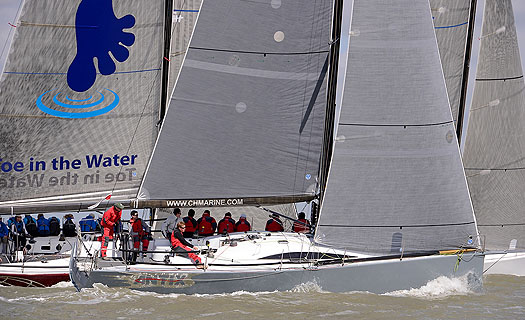
Doing the business. Anthony O'Leary's Ker 39 Antix settling into the groove on the way to the top place in the Easter IRC Championship. Photo: Rick Tomlinson
That in turn augured well for Ireland's Commodore's Cup chances, which then received a further boost last weekend when the crew of another Irish team wannabe, Quokka with Michael Boyd and Niall Dowling, had a winning weekend in the Warsash series with their temporary mount Tarka in anticipation of Quokka's return from the Caribbean at the end of May.

The Colours Match team racing between UCD and Trinity served up top sport in the Liffey, with Trinity winning. Photo: W M Nixon
Meanwhile the universities racing has been brought to life, for although UCD had a convincing win in the racing with the SailFleet J/80s to become the Irish team for the Student Yachting Worlds in France in the Autumn, before April was out the Colours Match in the Liffey under the burgee of the Royal Alfed YC, team-raced in Fireflies, saw Trinity take the honours in convincing style.
But if we're looking for something which really did set things freshly alight, it was out in Hyeres where the ISAF Championship saw the northern duo of Ryan Seaton & Matt McGovern take silver in the 49er, almost immediately moving them up the global rankings from 33 to 11, a quantum leap and no mistake.
The potential for serious success by these two has been fairly obvious for some time, but anyone who sails boats will know only too well how many factors have to come into alignment to get you up among the magic metals at the end of the day.

Stars of the silver sea – the Seaton/McGovern team took a silver medal for Ireland at Hyeres.
That their new global status was almost immediately acknowledged by this rankings improvement will in turn add heft to everything they do and say. Thus when, some time ago, the Ryan/Seaton equipe suggested that the 2016 Olympics sailing waters in Brazil are so off the standard as to be a health hazard, it attracted polite attention. But now that they're Number 11, and still counting down, much more notice is taken. And the fact that the Vice President of the International Olympic Committee has suggested, with something approaching despair, that the facilities in Brazil just aren't going to be ready for 2016 at any standard, all gives added legs to the statement from Ireland's 49er crew.
This in turn makes us wonder where world sailing might go in 2016 if the Brazilian setup is still Work in Progress. With tongue only slightly in cheek, we suggest they need look no further than West Cork, where Baltimore Sailing Club has been expanding its facilities to meet increased demand as a club which last year introduced something like 700 people to sailing. That BSC and current Mitsubishi Motors "Club of the Year" Kinsale YC further east along the West Cork coast have both been putting in premises up-grade during the past year, while other clubs have been having it tough, and just about hanging in there in some cases, surely gives pause for thought.
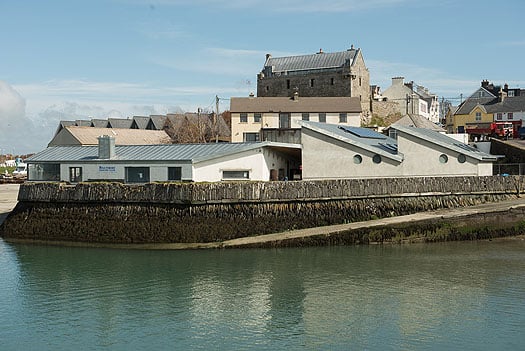
Olympic venue? The extended and up-graded Baltimore Sailing Club is ready and raring to go.
The economic shakeout of the past five years has caused a massive write-down in the value of almost all property and other assets. And in the case of yacht and sailing clubs, there has been a detailed examination of the continuing validity, or otherwise, of established yacht clubs and their traditional business model of quite high subscriptions under-writing other facilities which in turn combine to provide the complete package of an orthodox yacht club.
Inevitably, most clubs are run by officers and committee members who have been involved with the club for many years. Thus, like people who have been running a quality hotel for decades, they may have an inflated notion of what their organisation and its premises are actually worth. Admittedly there's only limited usefulness in comparing a yacht club with a hotel, but lessons can surely be learned. The fact is that hotels today are worth maybe only a third or even less of what they were reckoned to be worth six years ago. And equally, while yachts clubs certainly have a unique package to offer, is it unusual enough and special enough to charge high subscriptions when there are alternative facilities and services available?
The dilemma arises to some extent in all sailing centres. Last week we were discussing the story of the development of Howth YC. Today it is in the seemingly happy situation of having its own marina, thus it theoretically can offer an attractive all-in-one package to any potential member. But the very fact that Howth YC has done so much to help make Howth a colourful and vibrant sailing/fishing port is partly to its own disadvantage. The place has developed as a remarkable focus for top seafood restaurants. This means that the extensive club catering facilities – expected by traditional members - are constantly battling for business with a whole slew of award-winning eateries and characterful pubs nearby.
The problem is more acute in Dun Laoghaire in that the only club within the marina area is the Royal Irish YC. Thus while people may have been loyal members of the National, the Royal St George and the Dun Laoghaire Motor Yacht Club, they find that after going out in the boat, it's very easy to round out the evening aboard in the marina, chatting among themselves or with other crews on boats nearby, and then head straight for home without making their number in their home clubs at all.
This situation is less in evidence at weekends and during special events. But nevertheless it was causing such a lessening in mid-week club vitality that various steps have been taken, and the Royal St George's move to take over berths in a block booking in the outer marina, and service them by a frequent ferry direct from the clubhouse, is a visionary step.
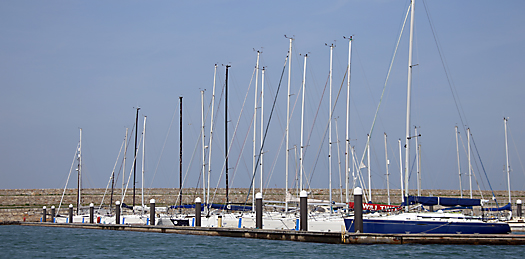
The Royal St George YC has introduced a direct ferry service from the clubhouse to its group of berths in the outer marina in Dun Laoghaire. Photo: David O'Brien
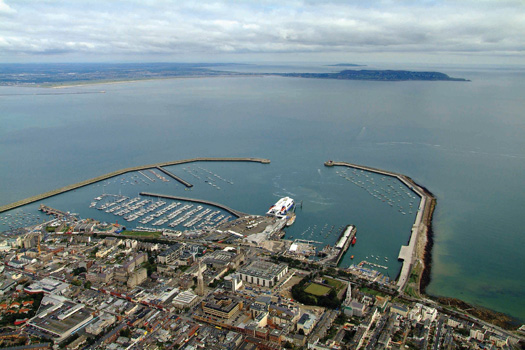
To overcome a lack of direct access to the Dun Laoghaire Marina, the Royal St George YC is running a ferry service from its clubhouse (to right of Stena Ferry, foreground) to the berths in the Outer Marina (upper left) Photo Kevin Dwyer/courtesy ICC.
Nevertheless, in all club administrations there are those who are of the opinion that, whatever the Honorary Treasurers may believe, there has to be a radical re-think of the primary subscription levels. In essence, they're suggesting that the book value of the club has to be written down such that subscriptions are halved. Personally, I haven't much of a notion of how to read a balance sheet, but the dogs in the street know that in the hospitality industry – which, in the broadest sense, is the area in which yacht and sailing clubs operate – values have been savagely slashed, and while charges may still seem high, at least the places are surviving as going concerns.
With continuing reduction in expenses across the board, one area in which there seems to be much work afoot is in the Irish Sailing Association, which in latter days had begun to seem like some hidden corner of the civil service, existing more for the benefit of staff than for the provision of services for sailors. It's amazing to learn that the ISA has sixteen fulltime staff, and a basic annual wages bill of something like €600,000. When you add in the expected benefits, it musty come in total to a very tidy yearly sum.
What on earth do they all do? While you'll invariably find the ISA logo in prominence at some top events, it has to be said that you're entirely unaware of the organisation's existence in any form at more everyday happenings, and it doesn't seem to be because they believe in doing good work by stealth. But with special study groups resulting from the major changes introduced in the ISA setup at the AGM in March, we can only hope that in time the Association will reflect the cost-cutting which has had to be introduced in the clubs, which provide the main part of the ISA's income.
While the administrative structures are rightfully being pared back in many areas of our sport, the coastal infrastructure, on which all forms of seagoing ultimately depend, continues to need maintenance and development. In this area, one very promising green shoot is the news that there are signs of movement in Dunmore East. A dredging programme is getting under way, and just this Tuesday, Minister for Marine Simon Coveney TD convened a meeting in the port to inaugurate a community approach to harbour development which, it is hoped, will help to invigorate the many places around Waterford Estuary, for which Dunmore East has the potential to be the true gateway harbour.

Dunmore East – can it fulfil its potential as the gateway leisure port for the Waterford Estuary? Photo Kevin Dwyer, courtesy ICC
In a more extreme marine environment, it has been confirmed that €6 million will be spent on improving the pier at Doolin in northwest Clare, the nearest mainland quay to the Aran Islands, which also caters for the tour boats cruising along the Cliffs of Moher. While the locals seem well pleased, I wouldn't get too excited about it. This is one very rugged part of the coast, and when you remember that it took €31 million to extend the pier at Kilronan in Inismor, the main Aran island, and another €14 million to build the little harbour at the north end of Inis Meain, the middle Aran island, then we can only hope that €6 million is going to achieve something more than a few boulders being shifted about in the roaring ocean at Doolin.

The pier at Doolin is decidedly minimalist, but it provides the shortest sea passage to the Aran Islands. Photo: W M Nixon
But then, in the west all things are possible, and along the ocean seaboard we're told that four thousand signs are being erected to guide people along the Wild Atlantic Way, the new tourism initiative using many smaller coastal roads. Quite so. Frankly, with signage at this level, it will be the Tame Atlantic Way by the time half of them are in place. I have to admit to being a complete curmudgeon in this. In many years of transitting Ireland's west coast by sea and land, one of our favourite areas while driving along the west coast has long been the coast south of Kilkee down to Loop Head, where the cliffs comfortably rival anything the vulgar Cliffs of Moher have to offer, and it is magnificently uncrowded. But not any more, if the Wild Atlantic Way movement has its way.
While I appreciate that visitor numbers have to be kept up and increased whenever and however, it has to be done in a way which appreciates that's what brings people to Ireland (rather than just to Dublin, which is a special case) is an unspoilt landscape. So, four thousand signs just for the one Atlantic Way? Ogden Nash had something to say about this:
"I think that I shall never see,
A billboard lovely as a tree.
But then, until the billboards fall,
I'll never see a tree at all".
Be that as it may, the final sign that suggests things are on the move again is a notice I spotted recently posted at a nearby club, though language pedants might wonder how a notice which manages to mangle so utterly the plural of "dinghy", even to adding a completely superfluous greengrocer's apostrophe, could be seen as encouraging in any way whatsoever.
Well, once you've overcome your opinions about the errors, the underlying message must be good news. More youngsters are evidently coming to sailing this year. And as for the spelling mistake, even that's an improvement. A year ago, the same notice board opened by referring to something called "a dingy", but this time round we have to get to the second line before finding that. And it all comes right for dinghies in the end.
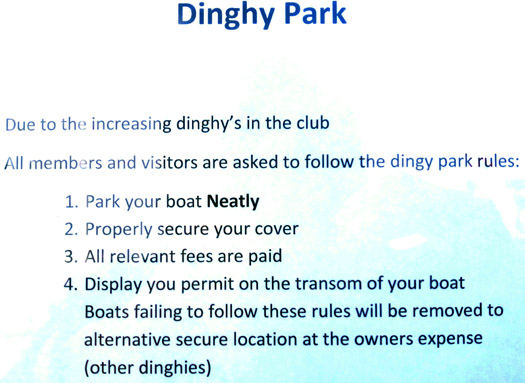
Sign of the times? Whatever about the spelling, this current notice at an Irish sailing club has an underlying message of good news. Photo: W M Nixon
#swchyeres – In a significant boost to their campaign for Rio 2016, Irish Olympic skiff sailors Ryan Seaton and Matt McGovern from Belfast Lough are medal contenders at the final day of the ISAF World Cup regatta in France tomorrow. The 49er duo finished five days of fleet racing this afternoon in third place overall. Of 80 teams competing, only the top 10 will now sail a further three races on Saturday – each worth double points – to determine the medals. Although 23 points separate the NI pair from Kiwi leaders Peter Burling and Blair Tuke the gold is still within reach.
Laser radial sailor Annalise Murphy will also be competing in a medal race tomorrow. The Laser Radial class will only have one double points race before the gold, silver and bronze are awarded. Murphy is currently lying in eighth place but separated from the top three by 36 points.
Three other Irish teams also competing at the event finished racing today. In the Paralympic Sonar class John Twomey, Ian Costelloe and Austin O'Carroll finished in seventh place overall. Andrea Brewster and Saskia Tidey finished 16th out of 42. James Espey was sailing in the men's Laser Standard fleet of 123 and finished 71st.
Seaton & McGovern Stay Second in 49ers at ISAF World Cup Hyeres
#49er – Ireland's 49er duo Ryan Seaton and Matt McGovern continue to hold second overall as the ISAF Sailing World Cup Hyères reached a critical stage on the French south coast.
Scoring 18,15 and 8 today they stay second overall narrowly ahead of Kiwi pair Marcus Hansen and Josh Porebski.
Peter Burling and Blair Tuke (NZL) showed a fine display of racing on the 49er course to stay out of trouble, avoiding a double point score like many of their competitors succumbed to. A ninth in the opening bout was followed up with a fourth and a ninth and they have a healthy 22 point lead with two days remaining.
Seaton and McGovern held on to second overall but they found the going tough discarding an 18th and count a 15th and an eighth to trail the Kiwis on 72 points. They are just a single point ahead of Hansen and Porebski
Germany's Erik Heil and Thomas Ploessel started the day emphatically in the gold fleet and in Race 10 narrowly missed out on the bullet to Manu Dyen and Stephane Christidis (FRA) as they came through in second. In Race 11 they hit back hard and were truly dominant. Leading from the outset they never truly looked threatened and eased through to a 15 second victory overall Nathan Outteridge and Iain Jensen (AUS).
Unfortunately it did not go to plan in the final race of the day for the Germans as a 25th puts them in ninth overall.
The final bullet of the day went to David Evans and Ed Powys who are 11th overall.
Over 1,100 sailors are competing at the fifth and final stage of the 2013-2014 ISAF Sailing World Cup series and it was long day out on the water with the last race concluding at 20:01 local time.
Following a delayed start to the day a shifty 10-12 knot westerly breeze tested the sailors' and the race committees.
Irish Sailing Coach Slams 'Disgusting' Rio Olympic Waters
#rio – An Irish Olympic sailing coach has slammed the future Olympic waters of Rio as 'disgusting', according to the Belfast Telegraph. Ian Barker, who won a silver medal for Britain in the Sydney 2000 Olympics' 49er class and now coaches Ireland, said it was the worst he had seen after sailing in 35 countries.
Sailors have expressed disgust at the filthy state of the Brazilian waters in which they will race at the 2016 Olympics, with a former British star describing it as a "sewer".
Barker was coach to Ireland's Tom Fitzpatrick and Frazer Brown in Athens 2004 and more recently to London 2012's Ryan Seaton and Matt McGovern.
He said sailors in training had to stop to disentangle their rudders from rubbish.
"It's a sewer," he told the Telegraph. "It's absolutely disgusting. Something has to be done about it. But you need the political will for these things to happen and at the moment it's not there."
"I've been sailing all over the world for 20 years now, and this is the most polluted place I've ever been," said Allan Norregaard, a Danish bronze medalist in the 2012 London Olympics.
"It's really a shame because it's a beautiful area and city, but the water is so polluted, so dirty and full of garbage."
The Belfast Telegraph has much more on the story including photos of the pollution here.





























